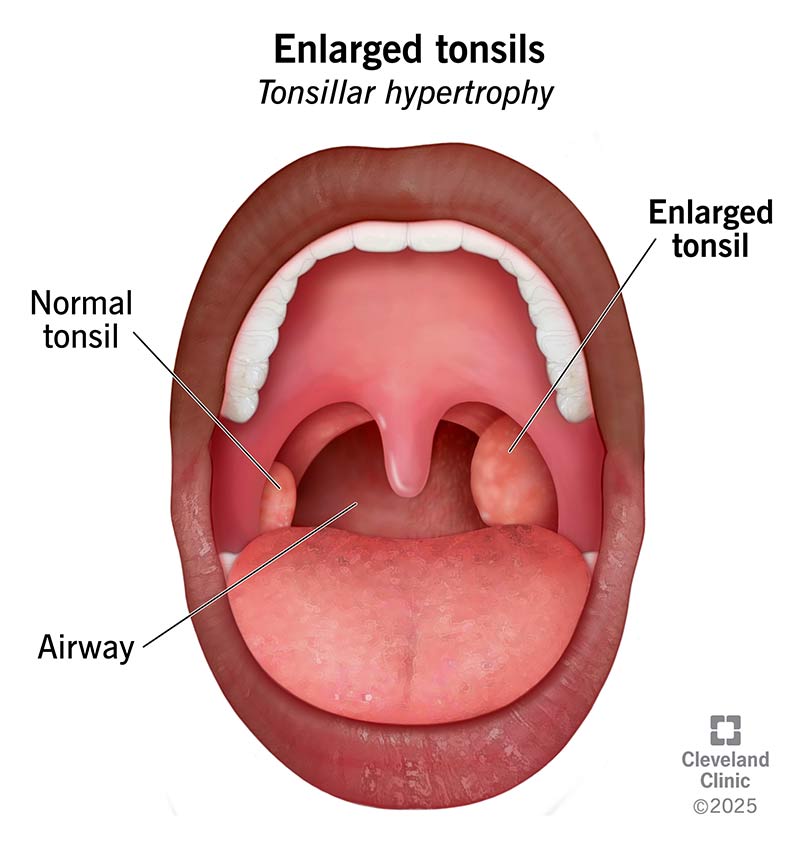Tonsillar hypertrophy happens when your tonsils (the two small fleshy mounds at the back of your throat) enlarge. It’s most common in children and is usually harmless. But your child may need treatment if their tonsils are so large that they partially block their airway. This can cause obstructive sleep apnea.
Advertisement
Cleveland Clinic is a non-profit academic medical center. Advertising on our site helps support our mission. We do not endorse non-Cleveland Clinic products or services. Policy

“Tonsillar hypertrophy” is the medical term for enlarged tonsils. Your tonsils are two small fleshy mounds on both sides of the back of your throat. Part of your immune system, they trap and kill germs that come in through your mouth and nose. They sometimes swell when this happens. Then, they return to their normal size.
Advertisement
Cleveland Clinic is a non-profit academic medical center. Advertising on our site helps support our mission. We do not endorse non-Cleveland Clinic products or services. Policy
But sometimes, tonsils stay enlarged. This is especially the case in children between ages 3 and 7. These are the prime years when kids fight off childhood illnesses.
Enlarged tonsils usually don’t need treatment unless they cause problems. If they’re blocking your child’s airway and interrupting their sleep, it’s time to see a healthcare provider.
Enlarged tonsils look bigger than normal. They may look red and irritated. Sometimes, they happen alongside symptoms like a sore throat or fever. If they’re big enough to block your child’s airway, they can cause:
Many factors can cause enlarged tonsils. Possibilities include:
Causes of tonsillar hypertrophy in adults can be the same as in children. Other causes include more serious infections (like HIV), cysts, benign tumors and cancer (uncommon). Tonsil cancer can cause one tonsil to be bigger than the other.
Advertisement
Not all causes of tonsillar hypertrophy are avoidable. But you can reduce your child’s risk of enlarged tonsils by helping them avoid getting sick. Teach them proper handwashing technique. Make sure they’re getting the right nutrition and enough sleep.
The most common complication of enlarged tonsils is obstructive sleep apnea (OSA). About 8 out of 10 children with OSA have enlarged tonsils. The lack of sleep can lead to irritability, behavioral changes and poor school performance. Not getting the sleep they need can increase your child’s risk for several conditions, including heart disease.
Over time, mouth breathing because of a blocked airway can lead to a misaligned bite. It can affect how the bones in your child’s face and jaw develop.
Enlarged tonsils can also increase your child’s risk of frequent or ongoing upper respiratory and ear infections.
Your child’s healthcare provider will ask about their symptoms. Then, they’ll examine their tonsils. They’ll likely use a wooden tongue depressor to get a clearer view of your child’s throat. They may check for swollen lymph nodes in their neck. Swelling usually means an infection.
Your child may need a throat culture to see if a bacteria is causing their tonsils to swell.
Your child’s healthcare provider may also assign a grade based on how much space your child’s tonsils take up in relation to their throat:
While much depends on your child’s symptoms, higher grades are more likely to require treatment.
Healthcare providers only treat hypertrophy of the tonsils that’s causing symptoms. Treatments include:
Your child may need a tonsillectomy to remove enlarged tonsils. This is the most common treatment for children with obstructive sleep apnea. Often, their provider will remove their adenoids, too. Adenoids, like tonsils, are part of the immune system. They’re also prone to swelling and can cause issues.
Not having tonsils or adenoids won’t prevent your child’s body from fighting germs. Other parts of their immune system will step up to fight illnesses.
Advertisement
Let your child’s provider know if your infant is having trouble eating and gaining weight. Let them know if your child is struggling to get enough sleep or is showing other signs of enlarged tonsils.
Usually, tonsils get smaller as children reach adolescence. So, enlarged tonsils may improve without treatment. But if your child is having symptoms, there are treatments that can help. Depending on the cause, your child may need over-the-counter or prescription medicine. If their tonsils are blocking their airway and interrupting their sleep, a tonsillectomy can usually fix the issue.
It’s not uncommon for children to get sick and have swollen tonsils. So, it can be hard to know when you should schedule a doctor’s appointment for them. The thing to remember is that occasional sickness is different from long-lasting sleep disturbances, noisy mouth breathing and irritability. These things may mean your child’s enlarged tonsils are interrupting their sleep. Without treatment, obstructive sleep apnea can impact your child’s development. The good news is that a tonsillectomy can help your child get relief. If you’re unsure of what to do to help your child, call their healthcare provider.
Advertisement
Cleveland Clinic’s primary care providers offer lifelong medical care. From sinus infections and high blood pressure to preventive screening, we’re here for you.

Last reviewed on 10/23/2025.
Learn more about the Health Library and our editorial process.